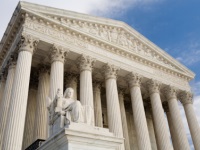
On February 26, 2014, the U. S. Supreme Court (“the Court”) held that the Securities Litigation Uniform Standards Act of 1998 (“SLUSA”) did not preclude Stanford Ponzi scheme plaintiffs’ state-law class action claims because the claims did not involve covered securities. The 7-2 majority opinion in Chadbourne & Parke, LLC v. Troice was written by Justice Breyer, joined by Justices Kagan, Sotomayor, Ginsburg, Scalia and Chief Justice Roberts. Justice Thomas concurred, and Justices Kennedy and Alito dissented.
The Court’s decision is significant because it resolves a long-standing circuit split over the interpretation of the “in connection with” requirement in SLUSA. As a result of the decision, plaintiffs may increasingly bring state law claims based on investment vehicles that are not covered securities themselves but whose performance implicates or is backed by covered securities. Investment managers and entities that market such investments, as well as lawyers and accountants, may face an increased risk of liability as a result of this decision.
SLUSA was enacted in 1998 to curb the increase in securities class actions filed in state court by plaintiffs seeking to avoid the stricter requirements of the Private Securities Litigation Reform Act of 1995 (“PSLRA”). SLUSA precludes any “covered class action” based on state law that alleges a misrepresentation or omission of material fact “in connection with” the purchase or sale of a “covered security.” SLUSA defines “covered security” to include only securities traded on a national exchange (or, not relevant to a case, a security issued by an investment company). Prior to the Supreme Court’s decision in Troice, the federal circuit courts had split in their interpretation of the “in connection with” requirement in this provision.
In Troice, four sets of plaintiffs filed civil class actions under state law, alleging that defendants helped Allen Stanford and his companies perpetrate a Ponzi scheme by falsely representing that uncovered securities plaintiffs purchased were backed by covered securities. The question facing the Court was whether claims alleging plaintiffs purchased uncovered securities (CDs not traded on a national exchange), buoyed by false allegations they were backed by covered securities, were precluded in state court under SLUSA. The federal district court granted defendants’ motions to dismiss holding that SLUSA barred the claims. The Fifth Circuit reversed, and the Supreme Court affirmed the Fifth Circuit’s decision holding that SLUSA preclusion did not apply. The Court reasoned, among other things, that a fraudulent misrepresentation or omission is not made “in connection with” a purchase or sale of a covered security unless it is material to a decision by one or more individuals (other than the perpetrator(s) of the fraud) to buy or sell a “covered security.”
The Court gave five reasons for its holding. First, the Court noted SLUSA’s basic focus is on transactions in covered securities, not uncovered securities. Second, the Court stated that its interpretation is supported by SLUSA’s language, because the phrase “material fact in connection with the purchase or sale” suggests “a connection that matters.” A connection matters where the misrepresentation makes a significant difference to someone’s decision to purchase or sell a covered security, not to purchase or sell an uncovered security. Third, the prior securities cases in which the Court found a fraud covered by SLUSA and Section 10(b) of the 1934 Exchange Act all involved victims who took, maintained or divested themselves of an ownership interest in a financial instrument that fell within the statutory definition. Fourth, the Court held that its interpretation is consistent with the language and purpose of the underlying regulatory statutes, the 1934 Exchange Act and the 1933 Securities Act. And fifth, the Court stated that a broader preemption would interfere with state efforts to provide remedies for victims of ordinary state-law fraud claims, thereby allowing SLUSA to preclude lawsuits applicable to garden-variety fraud.
The majority opinion also addressed the argument advanced by plaintiffs, and endorsed by the dissenting Justices, that the narrower approach to preemption taken by the Court in Troice could undermine the SEC’s enforcement capabilities, and may subject persons and entities whose profession it is to offer advice and counsel for investing in the securities markets to complex and costly state-law litigation. Justice Breyer, however, wrote that the Troice decision has no bearing on the scope of the government’s enforcement capabilities (as shown by the government’s successful prosecution of Stanford in the fraud at issue in the case), and only preserved the additional ability of investors to obtain relief under state laws when the fraud was sufficiently remote such that it was clear that the investor was not taking an ownership interest in a security traded on a U.S. exchange. Similarly, the only issuers and advisors who would continue to be subject to state law under Troice are those who do not sell or participate in selling securities traded on U.S. exchanges.
Finally, it is important to acknowledge that the nuances of SLUSA sometimes make it difficult to predict whether the next decision will expand or contract the operation of preemption in the securities context, as well as the availability of state courts to bring state law securities-related claims. Some may argue that Troice clearly opens up a new avenue for plaintiffs to bring class actions in state court that touch upon securities fraud, while others may note that the nature of the claims the Supreme Court explicitly green-lighted in Troice is not surprising and is what the statute intended all along.

